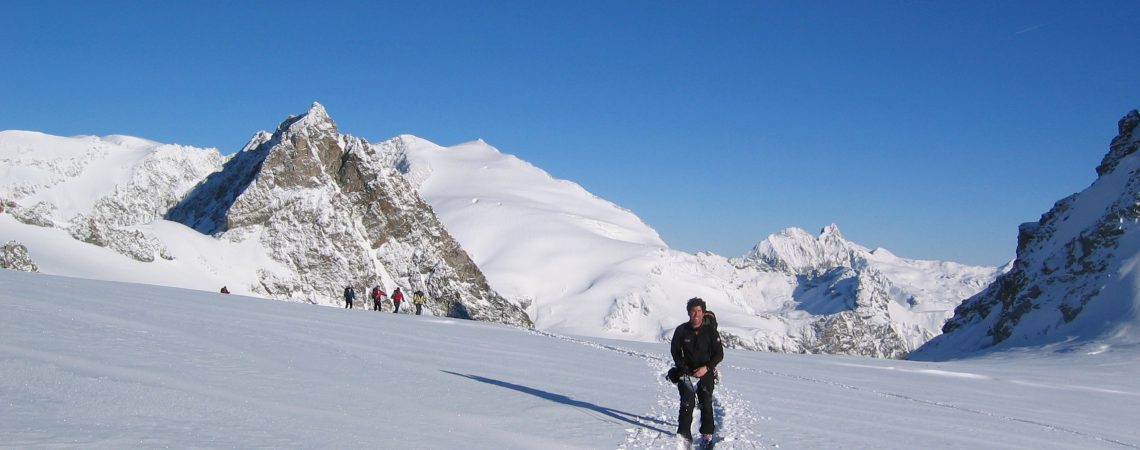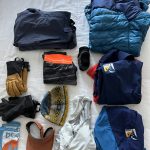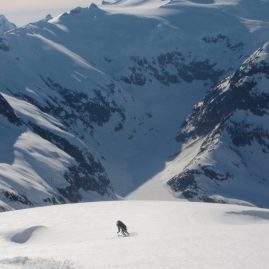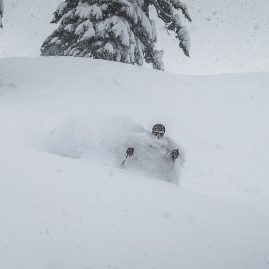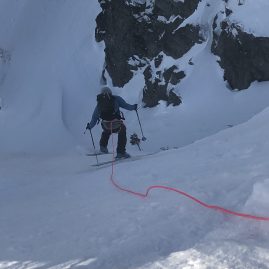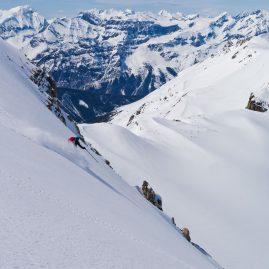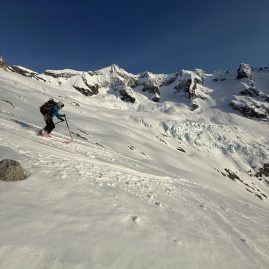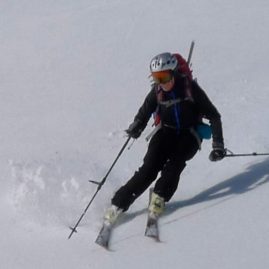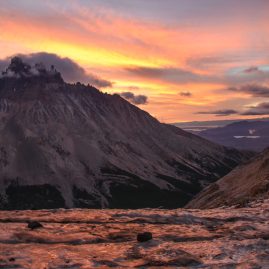Haute Route-The Original Tour that started it all
- Dates: 2026 – CUSTOM
- Duration: 7 Days
- Level: Intermediate
- Client Ratio: 5:1
- Cost:
- – $3150
- Included: group climbing equipment, and guide services.
- Not Included: All meals while on the mountain, airfare, transportation within Seattle, ground transportation hotel accommodations, restaurant meals, gratuities for guides, and all personal items.
The Haute Route is a classic tour through the heart of the Western Alps and some of its most stunning scenery. First completed in 1860, this high-level mountain traverse covers over 75 miles of alpine terrain, crosses over 12 different glacier systems, and connects the two major mountain centers − Chamonix, France and Zermatt, Switzerland.
This route is perhaps the most famous ski tour in the world. There are few places in the world where skiers can travel unencumbered, in the heart of the mountains, over high cols, hidden valleys, and immense glaciers. The huts in the Alps allow us to enjoy the skiing as only traveling light can. You’ll witness an amazing mixture of cultures while staying in these huts as you socialize with ski mountaineers from around world who are also taking on the challenge of the Haute Route.
The Haute Route is a tour for skiers with advanced skills who are able to ski in variable snow conditions. Skiers should be able to ski “off piste” in all types of ungroomed snow. Also, for our climbs skiers should be able to execute uphill kick-turns without difficulty. This is a challenging tour which requires skiers to be in excellent shape not just for the downhill skiing but also for the uphill sections. A basic knowledge of general mountaineering techniques is helpful. We will meet in Chamonix on the afternoon or evening before the tour begins to answer questions, begin packing and finalize other logistics.
Day 1
Depart from home.
Day 2
Hotel Gustavia, Chamonix – Check in to your hotel and get organized for tomorrow’s departure. Chamonix is a beautiful quaint French town with many great shops and restaurants.
Day 3
Vallée Blanche ski descent.– Meet in Chamonix. Discuss route plan and review equipment. Ride Aiguille du Midi and ski the Vallee Blanche where we have the opportunity for practicing skills on glacier. Night in Chamonix B, D
Day 4 – 1,270m ↑ 1,672m↓,10km, 5-7 hours
Trient Hut – Today we ride the tram at the Grand Montet and cross the Argentiere Glacier to reach the Col du Chardonnet.. We cross the Fenetre de Saleina then continue to the Trient Hut (10,370ft.,3170m). B, D
Day 5 – 200m ↑ 1,800m↓, 10km, 2-4 hours
Champex – Cross Col des Ecandies (9,145 ft., 2796m), descend to the Val d’Arpette to the quaint village of Champex situated by a pristine alpine lake. We will take a taxi to Verbier and spend the nigfht @Mont Fort Refuge. B
Day 6 1,200m ↑ 1,550m↓, 11km, 5-6 hours
After a hearty breakfast we start the long climb up to the summer of the Rosablanche before a long descent to the Prafleuri for evening beers and the night. B, D
Day 7 1,000m ↑ 700m↓, 9km, 3-6 hours
Highlights: The spectacular lac Dix and an afternoon rosti on the best hut’s patio on the whole trip!
A quick early-morning climb up the Col des Roux sets up for a long traverse above lac Dix. From the edge of the lake, a long skin takes us to what we consider the best hut of the trip, Cabane des Dix. Once at the hut, we have two options: beers and rosti or more north facing ski runs. B, D
Day 8 Cabane des dix – Cabane des vignettes 1,000m ↑ 750m↓, 9km, 3-6 hours
Highlights: Passage de la serpentine, Summiting the Pigne d’Arolla
This day is a big up followed by a big down. First, we head up the glacier de Tsena Refien over the spectacular passage de la serpentine and finally to the summit of the Pigne d’Arolla. Here we shed our skins and ski down the glacier de Piece to the steps of the Cabane des Vignettes for the evening. B, D
Day 9 1,700m ↑ 3,200m↓, 29km, 5-7 hours
Zermatt– Today we will descend slightly before climbing over the Col de‘Eveque (11,095ft.,3392m).We descend and cross the Glacier to cross Col du Mt. Brulé (10,510ft.,3213m) to the Col du Valpaline then enjoy the 2400 meter descent down the Stockji glacier under the Matterhorn and into Zermatt B, D
Our recommended clothing system has four layers.
- Base layer: manages moisture and wicks perspiration away from your skin. (Polypro, capilene, driclime)
- Softshell: should be a durable, comfortable, insulating and wind/water resistant layer that breathes well.
- Hard shell: windproof, waterproof and breathable. (e.g. Gore-Tex, or similar)
- Insulating layer: should be down-fill or synthetic-fill and fit over all layers. (e.g. down, primaloft or polarguard)
These four layers are usually sufficient for most people, but if you tend to be colder bring one extra medium-layer that would be ideal for extra warmth around camp, such as a vest. When deciding what to pack, remember to bring enough clothes and accessories to ensure your safety and comfort, while not over-burdening yourself with items you probably won’t use.
Ski Gear
- Adjustable Ski poles with powder (big) baskets*
- Skis or splitboard.Skis should be equipped with alpine touring bindings or telemark bindings. We prefer splitboards w/ skins.
- Alpine touring, telemark, or snowboard boots
- Skins with glop stopper (skin wax)
- Avalanche Beacon This needs to be Triple Antenna.
- Shovel Small collapsible style
- Avalanche Probe 265cm or longer
- Helmet for riding and climbing adjustable to fit over hats
- Ski Crampons
- Alpine climbing harness Must have adjustable leg loops and fit over all clothing and can be put on with ski boots
- Ice axe Lightweight
- Crampons with anti-ball plate * Must be fit to boots prior to trip,
- Crevasse Rescue Equipment Kit*:
- 4 Locking carabiners Large, pear-shaped carabiner is best, screw gate type recommended
- 4 regular carabiners (e.g. small wire gate are recommended)
- 1 double length sling
- 1 single length sling
- 1 Cordelette 6 mil 18-20’(6-7 meters)
- 1 12” Prussik or Hollow Block*
- 1 Microtraxion & Tibloc*
Upper Body
-
- Lightweight base layer T-shirt or long sleeve polypropylene shirt
- 2 synthetic sports bras*(WOMEN)
- 1 long sleeve Sun Hoodie Lightweight, light colored for sunny days
- Soft Shell
- 1 Down/synthetic jacket with hood
- 1 Hard shell jacket with hood Waterproof and breathable. roomy enough to fit over multiple layers.
- 1 pair liner gloves Thin wool or polypropylene
- Shell gloves or mitts
- Warm hat Wool or synthetic
- Balaclava or Buff
- Shade hat or baseball cap
Lower Body
- 2-3 heavy wool/synthetic socks Check boot fit with liner and wool socks on
- 1-2 pair lightweight long underwear Polypropylene or Capilene
- 2 pairs of underwear boxers/briefs
- Soft shell pants
- Shell pants Waterproof/breathable with full side zips
Backpack
- 30-40 liters capacity able to carry snowboard/skis
Miscellaneous Equipment
- Goggles and Sunglasses 100% UV protection with side shields or wrap around.
- Personal first aid repair kit Basics: moleskin/blister kit, Band-Aids, first-aid tape, ibuprofen, personal medications, spare parts for bindings and batteries etc.
- Lip balm At least SPF 20
- Sunscreen At least SPF 40
- Headlamp lightweight LED
- 2 1 Liter water bottles-one should be a thermos
- Toiletry kit with Toilet Paper
- Ear plugs
- Nylon stuff sacks For Lunch and pack organization
- Bandana
- Hand wipes
- 1 small stainless steel thermos (Optional)
- Favorite snack foods (no more than 2 pounds-lunch and snacks will be provided)
Intown & Hut Kit
- Casual clothing (cotton is fine) ie Travel, sweats, yoga wear.
- Slippers-ightweight booties or slippers, comfortable top and bottom-cotton optional.
- Prescriptions, medications
- Reading glasses
- Camera and chargers; digital device pre-loaded with games, music, books, films. and battery to charge them.
WILL MY GUIDE (OR GUIDES) BE?
You will receive an introductory email with the guide for your course. Pablo Puruncajas and Ian Nicholson lead all our Alps trips and will be one of the led guides. We are small company who enjoy working together in the mountains as well as highly skilled professionals who hold current Wilderness First Responder certification and are proficient in technical rescue and evacuation skills. Our guides are dedicated to the world of alpinism, many having first ascents and hold professional certifications with AIARE & AMGA. The AMGA is part of the IFMGA, which is the international body of certified mountain guides.
HOW MUCH SHOULD I TIP MY GUIDES?
Tipping is considered standard practice in the guiding industry. Tipping amounts vary – so $15-20 per day per person/per guide is average that works well for the guides without a serious blow to your wallet. Often 10% of the course cost is a good rule-of-thumb. If you feel that the program was exceptional or substandard the tip can reflect that.
CAN I RENT EQUIPMENT FROM BCAG?
Yes, we rent Beacons, Shovels, Probes and Packs here. If you need these plus touring equipment, Second Ascent rents avalanche safety equipment, alpine touring, tele and split boards click here. Quantities are limited so please contact us as soon as possible if you are interested.
HOW HEAVY WILL MY PACK BE?
You will carry 10-15 pounds, which will include everything on the equipment list.
WHEN DO I NEED TO PAY THE BALANCE OF MY TRIP?
Payable when you make your reservation by check, or credit card.
WHAT HAPPENS IF I NEED TO CANCEL MY TRIP?
If you should decide to cancel your trip, BCAG must be notified in writing. Your trip will be cancelled from the date we receive written notice. You will be assessed a cancellation fee according to the following schedule:
90 to 22 days from trip departure – 50% of trip cost
30 days or less – 100% of trip cost
WHAT HAPPENS IF I WANT TO CHANGE THE DATES OF MY TRIP?
Schedule changes are subject to a $50 fee per person up to 2 weeks out and $100 less then 14 days from the start of the trip and may not be possible. If conditions or circumstances preclude running a scheduled program we reserve the right to make the decision as to whether the program will be canceled, rescheduled, or an alternative provided.
WHAT HAPPENS IF BC ADVENTURE GUIDES HAS TO CANCEL MY TRIP?
In the rare circumstance where we need to cancel a program you can reschedule without a fee or receive a refund on your deposit. If circumstances arise that force us to cancel a program that is already in progress we reserve the right to decide whether a refund or credit, at a prorated rate, will be issued. We are not responsible for cancellation fees or costs arising from your changed or cancelled flights, lodging, or other arrangements. We strongly recommend obtaining trip cancellation insurance from your travel agent.
DO I NEED TO PURCHASE TRIP INSURANCE?
BCAG highly encourages the purchasing of trip cancellation and travel insurance on domestic trips and requires it on International trips. Europeans and Canadians use it because travel insurance provides coverage for trip cancellation and interruption, travel delays, loss of baggage and travel documents, baggage delays, medical expenses and emergency assistance.
Several options include Travelex or Travel Guard International at (1-877-248-8992) & www.travelguard.com for protecting your investment, however there are many companies to choose from and you may wish to do some individual research regarding which policy is right for you.
WHEN SHOULD I PLAN TO LEAVE A RETURN HOME?
We often get this question because most people need to know how much total time they need to take off work. Our Avi and Ski Tours begin by 8 AM at the trailhead and return to the car by 3. Our return to Seattle on the last day typically allows you to get back between 5-7 with the descent and drive back.


